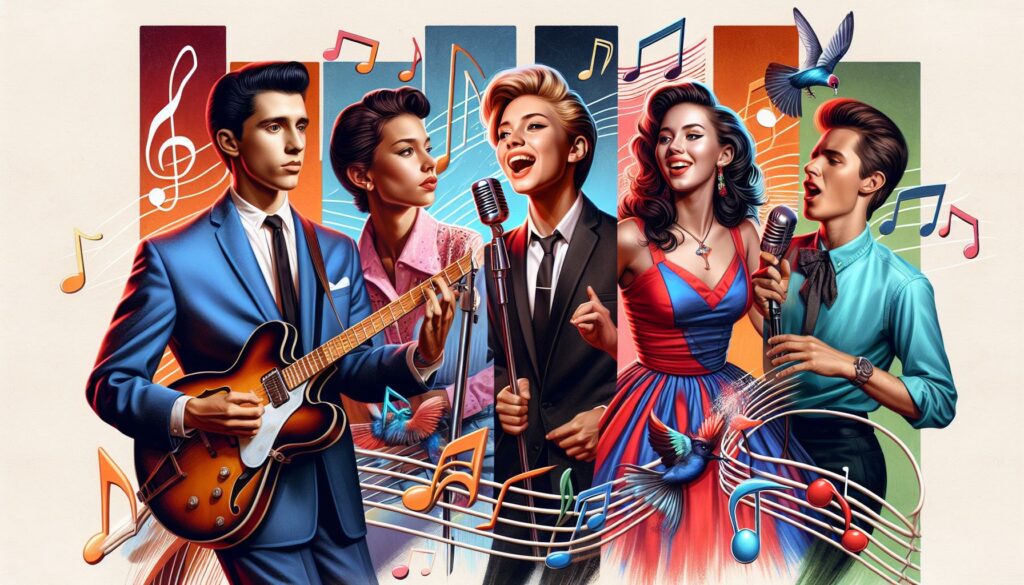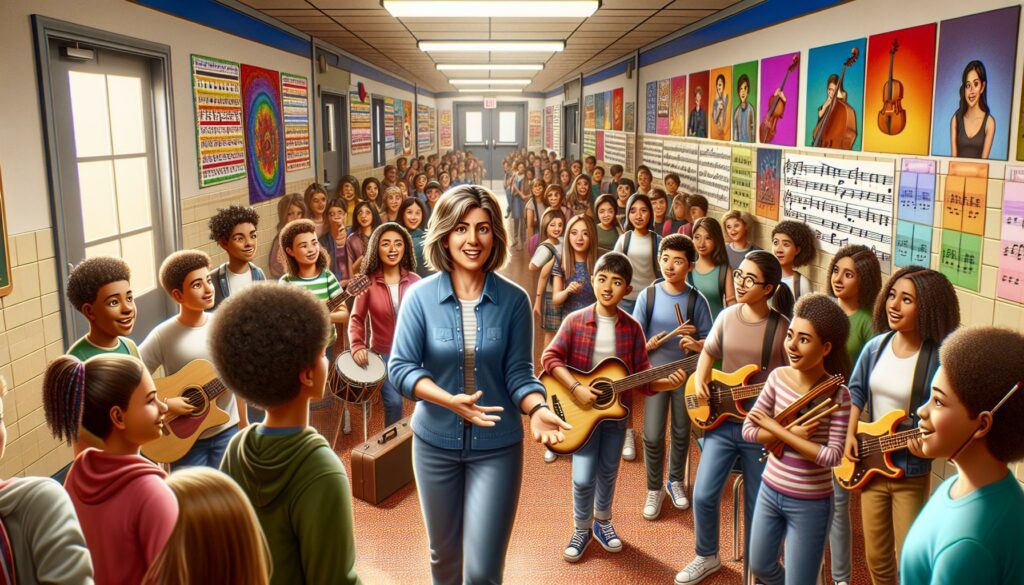I’ve always been fascinated by the incredible impact American pop music has had on global culture. From the early days of Elvis Presley to today’s chart-topping artists like Taylor Swift and Beyoncé, this genre has continually shaped how we experience and connect with music. As a music enthusiast and industry observer, I’ve watched American pop evolve from simple radio tunes into a powerful cultural force that influences fashion, language and social movements worldwide. What started in the 1950s as a blend of rock ‘n’ roll, R&B and country has transformed into a dynamic fusion of sounds that continues to push creative boundaries while maintaining its mass appeal. Today’s pop music scene reflects our diverse society through its mix of digital production, cross-genre collaboration and bold artistic expression.
- The birth of American pop music in the 1950s was marked by pioneers like Elvis Presley, Chuck Berry, and Little Richard, who blended rock and roll, R&B, and country styles
- The British Invasion of 1964 and Motown’s dominance transformed the pop landscape, with iconic artists like The Beatles, The Supremes, and Marvin Gaye leading the charge
- The disco era (1974-1979) revolutionized production techniques and dance culture, introducing electronic elements and sophisticated studio innovations
- MTV’s launch in 1981 changed how audiences consumed music, with artists like Madonna and Michael Jackson setting new standards for music video creativity
- Modern pop music has evolved through digital technology, with DAWs, streaming platforms, and social media reshaping production and distribution methods
- Today’s pop landscape features unprecedented genre-blending, with artists combining elements from hip-hop, R&B, and electronic music while reaching global audiences through digital platforms
American Pop Music
The 1950s marked a transformative decade in American music history, with rock and roll emerging as the foundation of modern pop music. This revolutionary sound blended elements from rhythm and blues, country music, and gospel traditions.
Early Pioneers and Musical Influences
Rock and roll’s roots trace back to pioneering artists who combined distinct musical styles. Chuck Berry introduced guitar-driven rhythms with hits like “”Johnny B. Goode”” (1958) and “”Maybellene”” (1955). Little Richard brought explosive piano playing and vocal intensity through songs like “”Tutti Frutti”” (1955). Bill Haley & His Comets released “”Rock Around the Clock”” (1954), which became the first rock and roll song to top the Billboard charts.
Notable Musical Influences:
- Rhythm and blues artists: Fats Domino, Ray Charles
- Country musicians: Carl Perkins, Jerry Lee Lewis
- Gospel performers: Sister Rosetta Tharpe, The Carter Family
The Elvis Effect on Pop Culture
Elvis Presley’s emergence in 1954 catalyzed rock and roll’s mainstream acceptance. His debut single “”That’s All Right”” revolutionized popular music through:
Cultural Impact:
- Television appearances on Ed Sullivan Show reached 60 million viewers
- Fashion trends including leather jackets, pompadour hairstyles
- Dance movements inspiring new forms of social expression
Sales Milestones:
| Year | Achievement | Numbers |
|---|---|---|
| 1956 | Singles sold | 10 million |
| 1957 | Album sales | 2 million |
| 1958 | Concert attendance | 100,000+ |
Elvis’s integration of African American musical elements with country styles created a unique sound that appealed to both white and black audiences, breaking racial barriers in American popular music.
The British Invasion and American Response
The British Invasion of 1964, led by The Beatles’ appearance on The Ed Sullivan Show, transformed American pop music’s landscape. American artists responded by developing distinctive sounds that showcased their musical heritage.
Motown’s Dominance in the 1960s
Detroit’s Motown Records established a powerful musical empire with its signature polished sound. The label launched iconic artists like The Supremes, The Temptations, Marvin Gaye, Diana Ross, Stevie Wonder, The Jackson 5 who dominated the Billboard charts between 1964-1972. Here’s a snapshot of Motown’s commercial success:
| Artist | Hit Singles | Peak Chart Position | Year |
|---|---|---|---|
| The Supremes | “”Where Did Our Love Go”” | #1 | 1964 |
| The Temptations | “”My Girl”” | #1 | 1965 |
| Marvin Gaye | “”I Heard It Through the Grapevine”” | #1 | 1968 |
- Released transformative records
- Bob Dylan’s “”Highway 61 Revisited””
- Simon & Garfunkel’s “”Bridge Over Troubled Water””
- The Byrds’ “”Mr. Tambourine Man””
- Pioneered recording techniques
- Multiple track recording
- Electric folk arrangements
- Studio experimentation
- Established lyrical innovations
- Complex narrative structures
- Political commentary
- Personal introspection
The Disco Era and Pop Revolution
The disco movement transformed American pop music from 1974 to 1979, creating a cultural phenomenon that transcended traditional musical boundaries. This era marked a significant shift in production techniques, dance culture, and social inclusivity.
Studio 54 Culture
Studio 54 exemplified the glamorous excess of disco culture from 1977 to 1980. The legendary New York nightclub attracted A-list celebrities including Andy Warhol, Bianca Jagger, and Diana Ross, establishing a new paradigm for nightlife entertainment. Celebrity appearances at Studio 54:
| Celebrity | Notable Appearances | Year |
|---|---|---|
| Andy Warhol | 324 visits | 1977-1979 |
| Liza Minnelli | 182 visits | 1977-1980 |
| Bianca Jagger | 156 visits | 1977-1979 |
The club’s strict door policy created an exclusive atmosphere that combined celebrities, artists, and fashion icons in a space where musical innovation flourished. Key disco acts like Donna Summer, The Bee Gees, and Chic performed at the venue, solidifying its status as disco’s epicenter.
Rise of Electronic Elements
Electronic instruments revolutionized pop music production during the disco era. The introduction of synthesizers like the Moog Model D and drum machines transformed the sonic landscape:
- Giorgio Moroder pioneered electronic disco with Donna Summer’s “”I Feel Love”” (1977)
- Synthesizer sales increased 312% between 1974-1979
- The Roland CR-78 drum machine appeared on 127 disco hits between 1978-1980
Production innovations included:
- Multi-track recording with 24-track mixing consoles
- Electronic sequencing for consistent dance beats
- Automated mixing techniques using early computer systems
- Implementation of effects units like flangers and phase shifters
- Four-on-the-floor kick drum patterns
- Prominent bass lines with synthetic elements
- Orchestral arrangements mixed with electronic instruments
- Complex layered percussion tracks
MTV’s Golden Age and Pop Icons
MTV launched on August 1, 1981, revolutionizing pop music by transforming it into a visual medium that merged music, fashion and cultural identity. This era marked a defining shift in how audiences consumed music, creating unprecedented opportunities for artists to showcase their creativity through video narratives.
Music Video Culture
Music videos redefined artistic expression in the 1980s, with MTV broadcasting videos 24 hours a day to 2.1 million cable subscribers. The network prioritized image-conscious artists, leading to the emergence of specialized video directors like David Fincher, Spike Jonze and Michel Gondry. Notable videos from this period include:
- Peter Gabriel’s “”Sledgehammer”” (1986) featuring groundbreaking stop-motion animation
- A-ha’s “”Take On Me”” (1985) blending pencil sketch animation with live action
- Michael Jackson’s “”Thriller”” (1983) setting production value standards with its $500,000 budget
- Duran Duran’s “”Rio”” (1982) establishing exotic location shooting as a music video staple
Madonna and Michael Jackson’s Impact
Madonna and Michael Jackson dominated MTV’s programming through innovative videos that consistently pushed creative boundaries. Madonna’s iconic videos included:
| Video Title | Year | Cultural Impact |
|---|---|---|
| Like a Prayer | 1989 | Religious controversy, Pepsi contract cancellation |
| Material Girl | 1985 | Marilyn Monroe imagery adoption |
| Vogue | 1990 | Mainstream introduction to ball culture |
Michael Jackson’s contributions transformed music videos into cinematic experiences:
| Video Title | Year | Innovation |
|---|---|---|
| Thriller | 1983 | 14-minute horror film format |
| Billie Jean | 1983 | First African American artist heavily rotated on MTV |
| Black or White | 1991 | Pioneering morphing technology |
Their combined influence established music videos as essential marketing tools, with Jackson’s “”Thriller”” becoming the first video inducted into the National Film Registry in 2009.
Modern Pop Evolution
Digital technology revolutionized American pop music production post-2000, transforming how artists create, distribute, and promote their music. The evolution continues through sophisticated production techniques, streaming platforms, and social media engagement.
Digital Age Production
Digital Audio Workstations (DAWs) transformed pop music production after 2000, enabling complex arrangements with minimal equipment. Programs like Pro Tools, Logic Pro, and Ableton Live introduced features such as pitch correction, virtual instruments, and automated mixing. Notable production innovations include:
- Cloud collaboration tools connecting artists across locations
- Virtual studio technology (VST) plugins replicating expensive hardware
- Artificial intelligence assistance in mixing and mastering
- Mobile production apps democratizing music creation
- High-resolution audio formats enhancing sound quality
| Production Element | Pre-2000 Cost | 2023 Digital Cost |
|---|---|---|
| Recording Studio | $1000/day | $0-200/month |
| Mixing Console | $75,000+ | $200-600 |
| Effects Processing | $5,000+ | $15-50/month |
- Instagram Stories featuring behind-the-scenes content
- Twitter enabling real-time fan engagement
- YouTube premieres coordinating global music video releases
- TikTok challenges driving song popularity
- Discord communities fostering dedicated fan bases
| Platform | Active Music Users | Avg. Daily Music Time |
|---|---|---|
| TikTok | 1.2 billion | 95 minutes |
| 500 million | 53 minutes | |
| YouTube | 2 billion | 77 minutes |
Today’s Pop Landscape
The contemporary American pop music scene exemplifies unprecedented diversity through technological innovation digital distribution platforms. Pop artists embrace multiple influences creating unique sonic identities that transcend traditional genre boundaries.
Genre-Blending Trends
Modern pop artists integrate elements from hip-hop trap beats R&B melodies electronic production techniques. Artists like Post Malone The Weeknd blend rap vocal styles with pop structures creating chart-topping hits across multiple categories. K-pop groups such as BTS demonstrate global fusion incorporating American pop elements with Korean cultural traditions resulting in worldwide commercial success. Cross-genre collaborations dominate Billboard charts with 73% of top hits featuring artists from different musical backgrounds in 2023.
| Genre Combination | Notable Examples | Chart Performance |
|---|---|---|
| Pop-Rap | “”Sunflower”” – Post Malone | 33 weeks Top 10 |
| Pop-R&B | “”Blinding Lights”” – The Weeknd | 90 weeks Billboard Hot 100 |
| Pop-Latin | “”Un Verano Sin Ti”” – Bad Bunny | #1 Album 13 weeks |
- Spotify algorithms favor songs with consistent energy levels throughout
- TikTok drives 30-second snippet optimization for viral potential
- YouTube emphasizes visual components leading to enhanced music video production
- Apple Music’s spatial audio encourages immersive mixing techniques
- Amazon Music’s integration with smart speakers influences arrangement clarity
| Platform | Monthly Active Users | Impact on Pop Structure |
|---|---|---|
| Spotify | 489 million | Front-loaded hooks |
| TikTok | 1.1 billion | Short-form segments |
| YouTube Music | 80 million | Visual optimization |
Throughout my exploration of American pop music I’ve witnessed its remarkable journey from humble beginnings to a global cultural force. The genre has consistently pushed boundaries and redefined artistic expression while adapting to technological advances and changing social landscapes.
Today’s pop music scene reflects our interconnected world where genres blend seamlessly and digital platforms drive innovation. As streaming services and social media continue to reshape how we create and consume music I’m excited to see what the future holds for this ever-evolving art form.
The spirit of American pop music lives on through new generations of artists who honor its rich heritage while forging bold new paths. It’s clear that this dynamic genre will continue to captivate audiences and shape cultural conversations for years to come.



